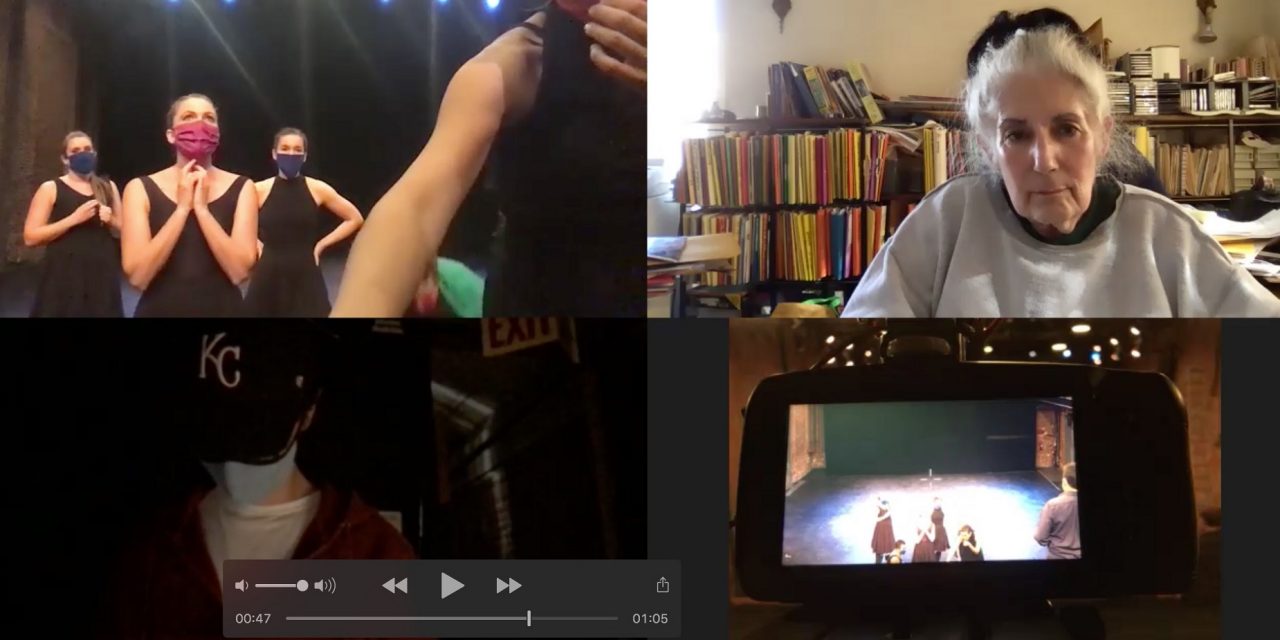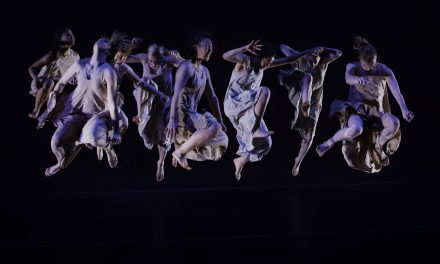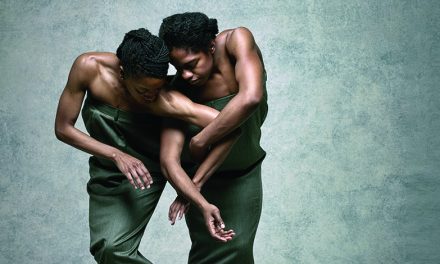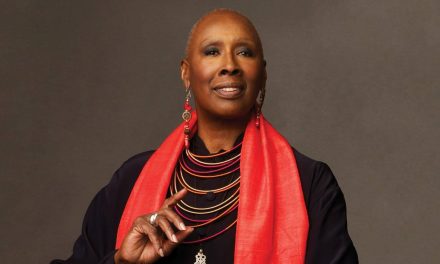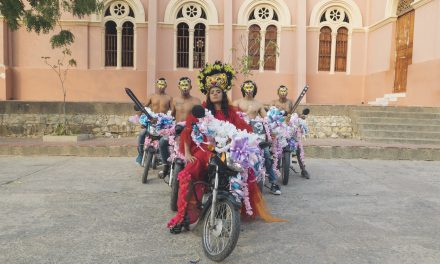As one of Los Angeles’ longest established contemporary dance companies, LA Choreographers & Dancers/Louise Reichlin & Dancers is celebrating its 40-year anniversary – founded in 1979. Because of the Covid pandemic, the company is streaming a new version of Reichlin’s 1992 critically acclaimed work titled Urban and Tribal Dances on Vimeo now through December 31, 2020. Reichlin selected several of the six sections from the original work to be re-imagined as Urban and Tribal Dances 2020.
Reichlin contacted me to suggest that I report on the process of her company members getting together physically for the first time in months to video the work while she remained at home to rehearse and oversee the videotaping via Zoom. I agreed that this would make an excellent and interesting story for LADC’s readers and sent her a few questions via email.
JS: What was the genesis of this latest production of Urban and Tribal Dances?
LR: After 2 years creating projects for performances in their senior center (Tap Dance Widows Club and A Jewish Child’s Story) I wanted to reimagine one of my most highly regarded works I had done in the early 90’s called “Urban and Tribal Dances” at a theater we had been in many years earlier, the Ivy Substation. We started rehearsing it, 5 of the 6 sections, on returning from New York in January where we had been showcasing. It seemed logical as besides 4 or 5 school residencies, we were to have the Orange County Dance Festival first in April where we would do two sections, a performance in Carlsbad in May, and projected this in July. In Mid-March everything shut down, including our rehearsal studio, and we didn’t know what was going to happen.
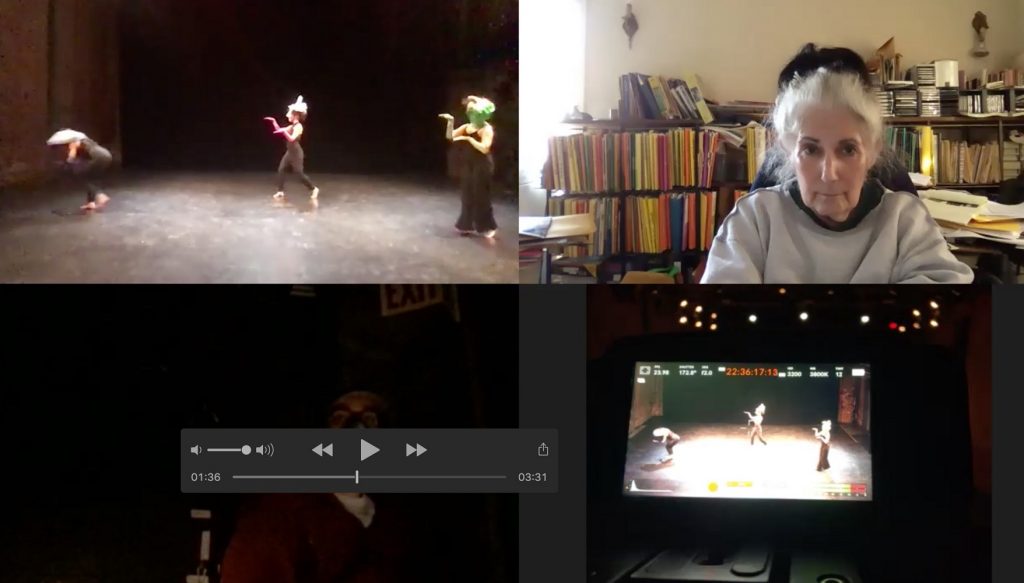
Louise Reichlin & Dancers in production – “Batida” by Louise Reichlin – Zoom capture courtesy of the company
JS: Please describe the process and the hurdles that you had to overcome?
LR: When we got back into the studio for 2 rehearsals in July, we found our main prop for Alone, a tent, had been thrown away by mistake, and then the studio was forced to close again. We were back in our homes again. The first work we put together was Alone 2020 for the San Pedro Festival of the Arts, in September, more nearly finished for the LA Dance Festival.
JS: What changes in the work were you forced or inspired to make?
LR: Alone 2020 was created totally without any personal meetings, using a video of the original dance since our tent was now gone. That work was always about a person living by themselves tied to the dwelling by their phone, and 30 years later, this was still the case but more people lived in tents. But we wanted to do the group sections, and all the studios were closed. Then we realized that we could be classified as Music Video/Film since we were not rehearsing for anything live, so we began working in an outside space, and the theater agreed to allow us to rent for shooting. We choose only the pieces with no body contact because of COVID 19 safety, and the biggest challenge was conveying the rhythms in Together, the only work we hadn’t begun before the Pandemic. Zoom in an outside setting is very glitchy, so the dancers would record a dance, email it to YouTube.com and send me the link. Then I could give accurate notes, as I was Zooming from home. I wanted to retain the minimal nature of the choreography, but also felt that because the dances were metaphorical in nature, some elements should become more specific to this unusual time we are living in. An example is that the end of Batida, which melded sophisticated veneer combined with primal energy (very much of an earlier time) now has the dancers just drop, as so many are just dropping with the virus.
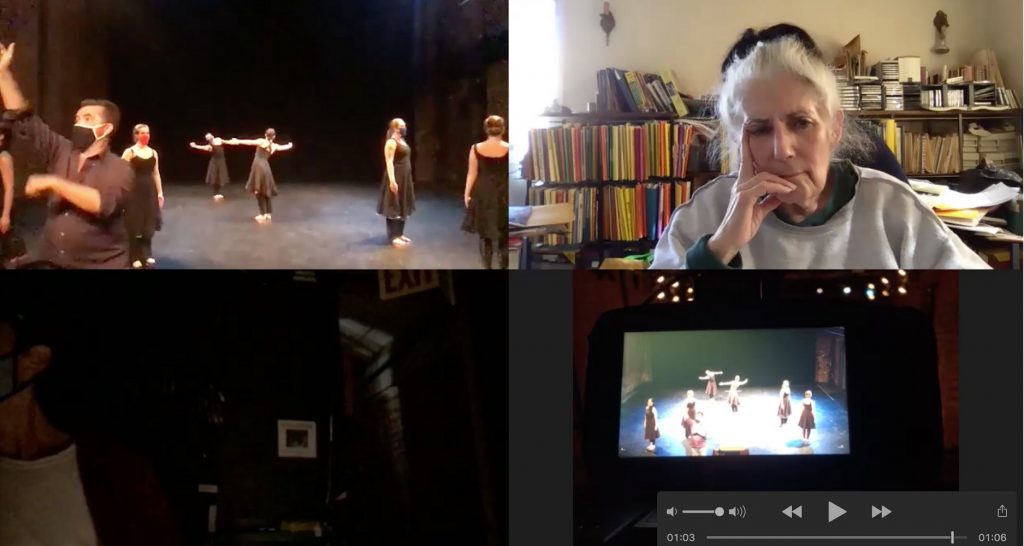
Louise Reichlin & Dancers in production of “Urban and Tribal Dances 2020” – Bosco Flanagan setting lights – Zoom capture courtesy of the company
JS: Referring Reichlin to a one of the company’s press releases, I asked her to explain the following statement more fully “Each dance has been edited with additional clips to become a part of the present Pandemic with a character of a nurse, and the reality of our deeply divided country.
LR: Remembrance was created after a section called War (not done here- too much body contact for safety). It is one that I have reimagined over the years – it was originally part of this suite after a section called War, as the Gulf War was happening at that point. Then it was used in The E-mail Dances in the mid-nineties adding an introduction section about my relatives killed during the holocaust. It was used again in The Baggage Project in 2011 and 12, with media by Audri Phillips. The multimedia content for Remembrance, had additional people added through a Facebook campaign in which users were encouraged to share photos and stories about lost loved ones. It was created after the death of my husband and creative partner, Alfred Desio. A deeply personal piece, we were remembering Alfred who had passed on in 2007, my father, the husbands of the women in Tap Dance Widows Club, a work we are still performing, plus a number of others through the Facebook page. It was also performed at several festivals, and finally reimagined for this expanding the original solo to 2 figures, the character of a nurse as this section honors those who are helping us get through this Pandemic, so instead of two dead people, her figure succumbs and becomes the other dead body. The main figure in white is still there. People have projected her as someone who guides all who are no longer with us and waiting for those who are still here. I cry when I see the health workers surrounded by so much death, and again, I felt this could be very specific at this time. From the original work, Variety had written, “Costumed in surreal headdresses and makeup, the dancers conveyed the interconnectedness of human existence, juxtaposed with the isolation experienced even in the midst of society.” Never very political in my career or in life, I have trouble understanding how as a democracy we have become so unconnected to each other, and how quickly intolerance and violence have become the norm (supposedly each of us has our own social media and news networks and totally believes only our own reality). I augmented Together with clips expected and unexpected before and after that I feel shows this dichotomy without taking sides. The dancers are interconnected- we are not at this time and it is disturbing.
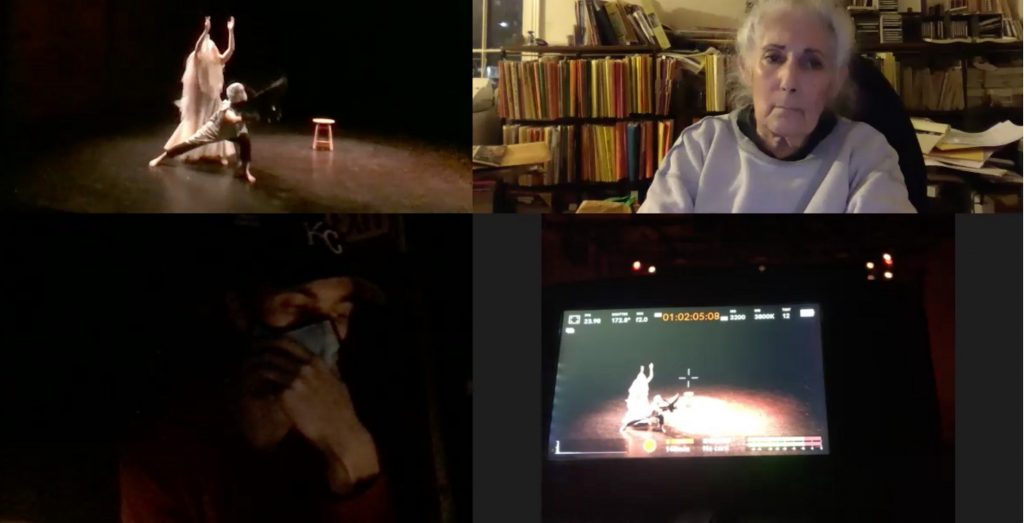
Louise Reichlin & Dancers in production – “Remembrance” by Louise Reichlin – Zoom capture courtesy of the company
JS: Who helped you with the filming and editing process?
LR: I called a videographer, Devin Schiro, who has been shooting my projects, usually just recording the performances, for about seven years or so, and told him I needed this done totally for the camera with many recordings. He has always worked with 2 cameras. Because I couldn’t see his actual recordings (not being at the theater) although Zoom allowed me multiple windows to see the stage area and a microphone to set lights and direct, I had him drop off drives of the first day’s shoot the next day both to me and the editor, as our time to edit was shorter than I would have preferred. Because we had already scheduled a second 1/2 day in the theater (although only 1/2 our dancers were available), we were able to get shots I didn’t have and by then understood that Remembrance needed only frontal shots that breathed with the dancer, unlike the other dances. Batida needed closeups with the three dancers that were there, so that worked. I am a trained Avid editor (one of the perks about free classes from Cinema Department I could take while on Faculty at USC in Music and Theater Departments) but am fortunate to have found Andrew Zutta to do the heavy lifting. His job is actually doing news editing for Telemundo on the night shift, and is also a dancer, so coordinating our schedules is always a little crazy. He has been editing my media projects since 2009 or longer and is able to technically get timing and ideas I ask for that I have long forgotten how to achieve myself. On Alone 2020 I sent him a bunch of Zoom shoots and the original footage, and he overlapped them for me, and that gave me ideas on where to go next with that one. The ones in the theatre are much more theatre oriented in perspective.
JS: What reactions did you receive from the dancers about working together in a theater again?
LR: They were ecstatic!!! We talk about it in an added “About the production with the artists” file.
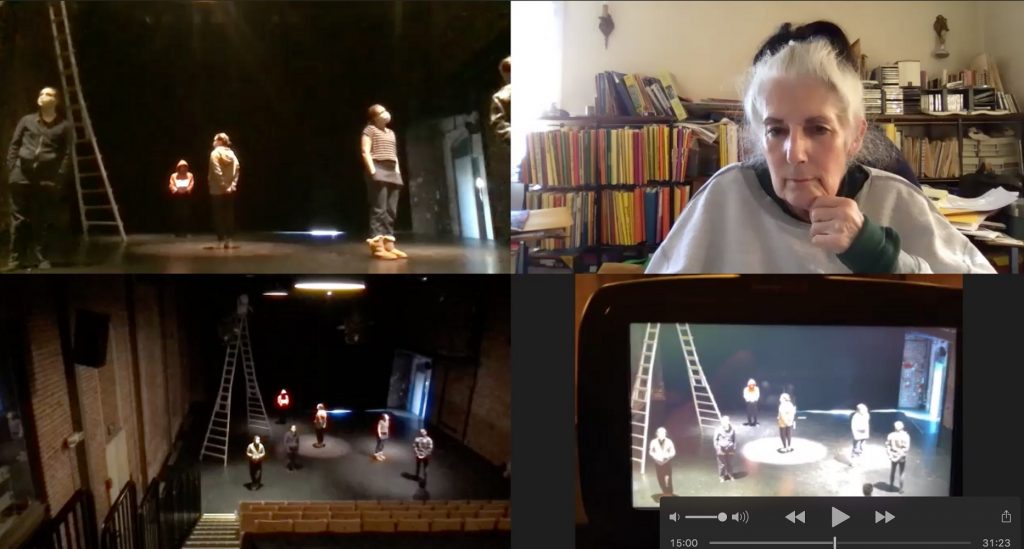
Louise Reichlin & Dancers in production for “Urban and Tribal Dances” – Zoom capture courtesy of the company
JS: Any similar plans in the works for you?
LR: I am always concerned with the safety of the dancers and like everyone, ready for this Pandemic to be over. I am a bit behind in some necessary work with new contracts with the LAUSD and insurance. Our original EIDL loan for the dancers is pretty much spent, so I also am incredibly grateful for the grant from the LA County COVID-19 Arts Relief Fund, as we were not successful in any other company local government funding for Covid-19, and that does end Dec 30, hence our quick turnaround time. But we all feel much more ready to create because of the “essential worker” category for video and film. I think all of us got stuck in the live dancer mentality, which we still have and crave, but interesting new opportunities are being presented to us. And I do want to add the other two dances from Urban and Tribal Dances called War and Wedding on video in a more filmic style – but we have to get closer than 6 feet from each other, so it will have to wait.
The artists involved in Urban and Tribal Dances 2020 included: Costumes: Linda Borough, Media: Audri Phillips, Lighting: Bosco Flanagan, Videography: Devin Schiro, Editing: Andrew Zutta and Louise Reichlin. Dancers: Jill Elaine Collins, Coree McKee Gonzalez, Corrina Gemignani, Katelyn Martin, Eve Metsäranta, Danny Guerrero.
I would like to thank Reichlin for suggesting this story and for taking the time to answer my questions for LA Dance Chronicle.
Urban and Tribal Dances 2020 runs through December 31, 2020. You may access them free of charge by clicking HERE.
To visit the Louis Reichlin Choreographers & Dancers website, click HERE.
By Jeff Slayton for LA Dance Chronicle.
Featured image: Louise Reichlin Choreographers & Dancers during the shooting of Urban and Tribal Dances 2020 – Notes with videographer Devin Schiro – Zoom capture courtesy of the company.

